National cancer incidence and mortality in China, 2012
Introduction
Cancer is one of the major non-communicable diseases in China and around the world. It is now the leading cause of death, causing about one fourth of all deaths in China (1). The National Central Cancer Registry (NCCR) is responsible for collecting population-based cancer registration data from local cancer registries for cancer statistics and publishing cancer registry annual report. The cancer registration data are not only widely used for cancer control and decision making, but also for scientific research (2). In this article, we provide a comprehensive overview of cancer incidence and mortality rates, and estimate new cancer cases and cancer deaths in 2012.
Materials and methods
Data source
The NCCR is a department of National Cancer Center, which is in charge of population-based cancer registry with responsibility of data collection, evaluation and publication from local cancer registries in China. The cancer registration data reported to cancer registries were from local hospitals, community health service centers, the Basic Medical Insurances for Urban Residents and the New-Rural Cooperative Medical System. By 1st June 2015, 261 cancer registries (100 cities and 161 counties) from 31 provinces submitted 2012 data to the NCCR. Data covered about 239,034,428 people, accounting for about 17.65% of the national population at the end of 2012. All cancer cases were classified according to the International Classification of Diseases for Oncology, 3rd edition (ICD-O-3) and the International Statistical Classification of Diseases and Related Health Problems 10th Revision (ICD-10). There were 193 qualified registries finally accepted for the estimation of incidence and mortality in 2012.
National population estimates
The national population in 2012 was estimated based on the 5th National Census data (2000) provided by the National Statistics Bureau of China, taking into account of the changes of age composition, gender ratio and the proportion of urban and rural transformation released by the National Bureau of Statistics (http://data.stats.gov.cn/). The national population in 2012 was stratified by area (urban/rural), gender (male/female) and age groups (0−, 1–4, 5–84 by 5 years, 85+ years). The age-specific death probability was adjusted referring to the Six National Census in 2010. Linear changes were assumed in each age group between the fifth and sixth Population Census.
Quality control
The NCCR checked and evaluated the quality and comparability of submitted data based on “Guideline for Chinese Cancer Registration” and referring to relevant data quality criterion of “Cancer Incidence in Five Continents Volume IX” by International Agency for Research on Cancer/International Association of Cancer Registries (IARC/IACR) (3). The data included in the final analysis should meet the following criteria: the percentage of cases morphologically verified (MV) (%) was not lower than 66%, the percentage of death certificate-only cases (DCO) (%) was lower than 15%, the mortality to incidence ratio (M/I) was between 0.6 and 0.8, and the percentage of the diagnosis of unknown basis (UB) (%) was lower than 5%.
Statistical analysis
Incidence and mortality rates were calculated by area, gender and age groups. The number of new cases and deaths were estimated using the 5-year age-specific cancer incidence/mortality rates and the corresponding populations. The Chinese population in 2000 and World Segi’s population were used for age-standardized rates. The cumulative risk of developing or dying from cancer before 75 years of age (in the absence of competing causes of death) was calculated and presented as a percentage. Software including MS-Excel, IARCcrgTools2.05 issued by IARC and IACR were used for data checking and evaluation (4). SAS software (SAS Institute Inc., Cary, USA) was used to calculate the incidence and mortality rates.
Results
Data quality
There were 193 registries accepted by this analysis distributed in 29 provinces, including 74 cities and 119 counties, and covering 198,060,406 of populations, including 100,371,169 males and 97,689,237 females, accounted for 14.63% of national population in end of 2012.
The overall indicators of MV%, DCO%, and M/I ratio were 69.13%, 2.38% and 0.62, respectively. They were 70.63%, 2.63% and 0.59 in urban registries, compared to 67.31%, 2.09% and 0.65 in rural. The quality evaluation for major cancers is presented in Table 1.
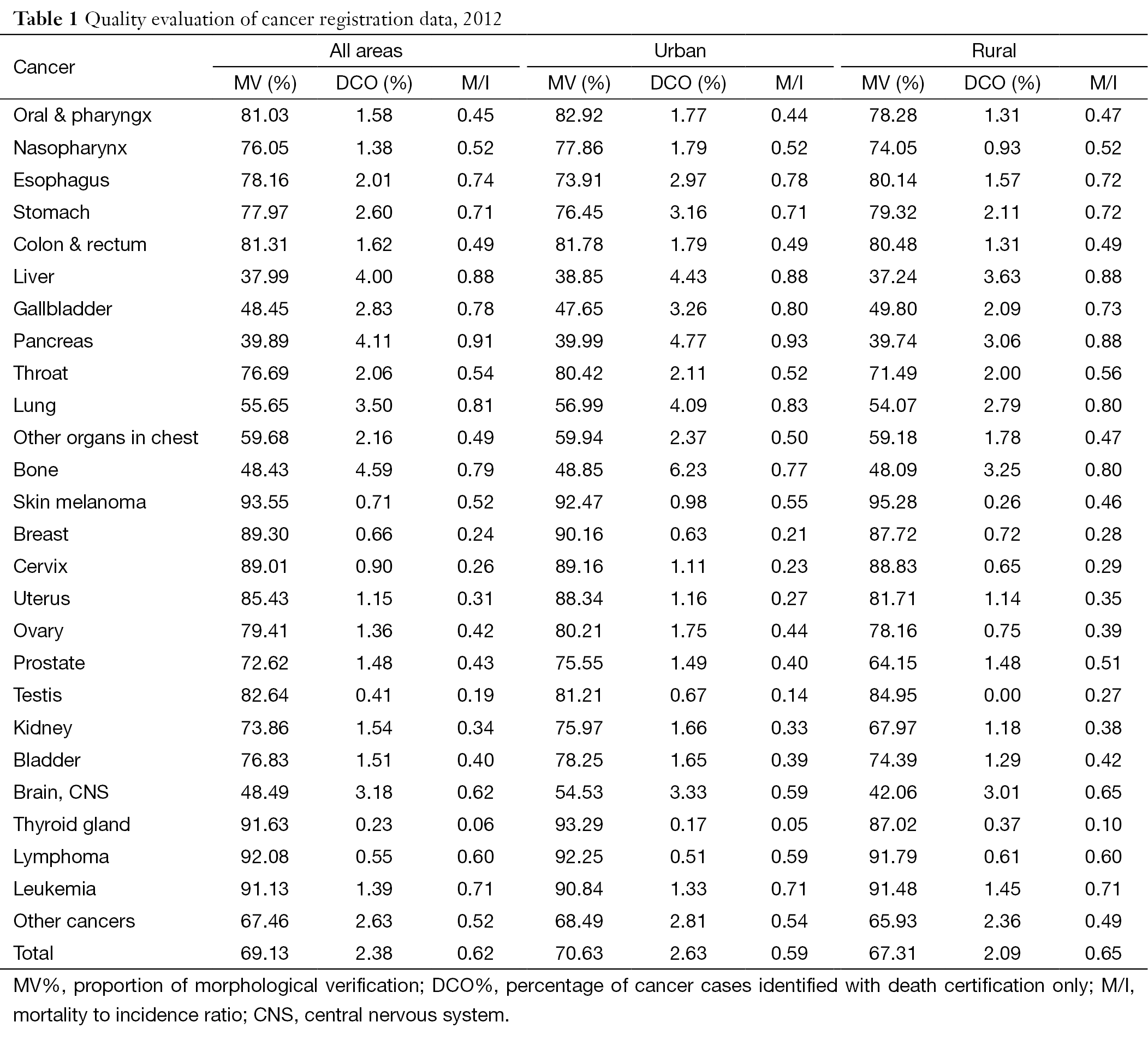
Full table
Incidence and mortality of overall cancers
Incidence
It was estimated that there were 3,586,200 new cases diagnosed as cancer in 2012. The crude incidence rate of all cancers was 264.85/100,000 (289.30/100,000 in males and 239.15/100,000 in females). The age-standardized incidence rates by Chinese standard population (ASIRC) and by world standard population (ASIRW) were 191.89/100,000 and 187.83/100,000, respectively. Among the cancer patients aged 0–74 years, the cumulative incidence rate was 21.82%. The crude incidence rate and age-standardized rate in urban areas were higher than that in rural areas. The crude incidence rates in males and females were higher in urban than in rural. However, after adjusted by age, the cancer incidence rate for males in rural was higher than that in urban areas (Table 2).
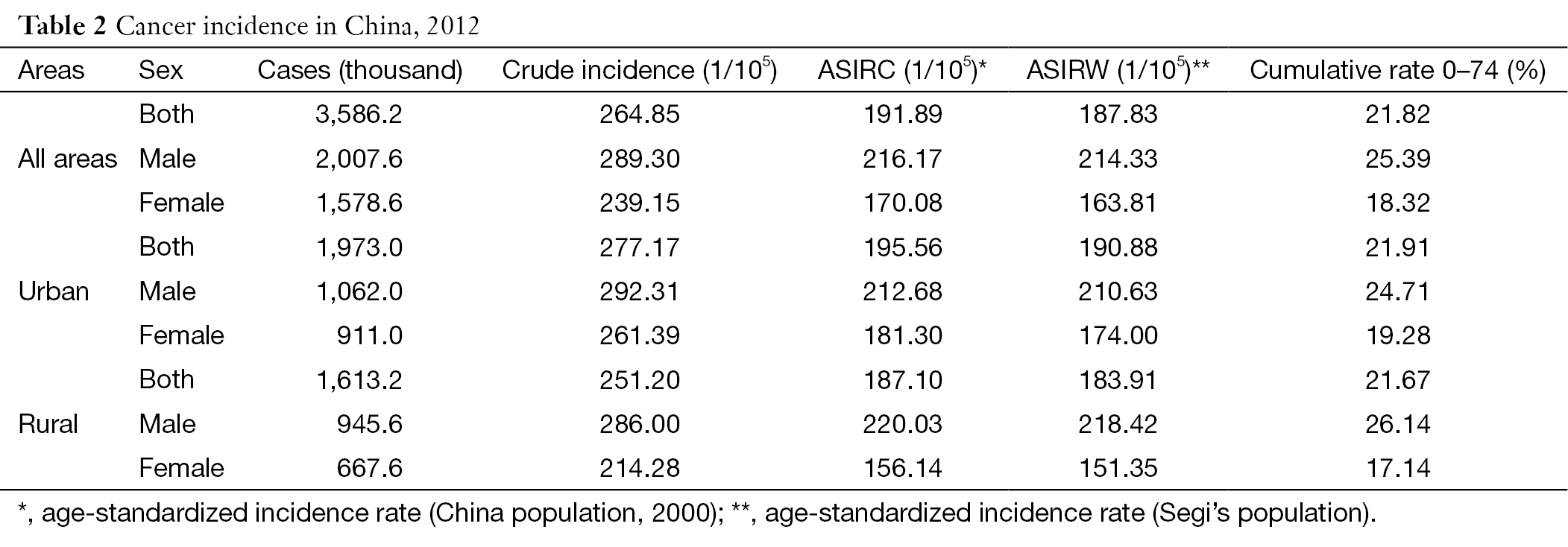
Full table
Age-specific incidence rate
The age-specific incidence rate was relatively lower before 40 years old, then increased dramatically and peaked at age group of 80–84 years (Table 3, Figure 1). The pattern was similar between urban and rural areas. Comparing the age-specific incidence rate between urban and rural areas, except age from 55–69, urban areas had higher incidence rates than that in rural areas. Between age of 35–74, most age groups of males in rural had higher incidence rate than that in urban. However, in females, the incidences were higher in urban than that in rural areas in every age group except for age group of 5–9 years (Table 3, Figure 1).
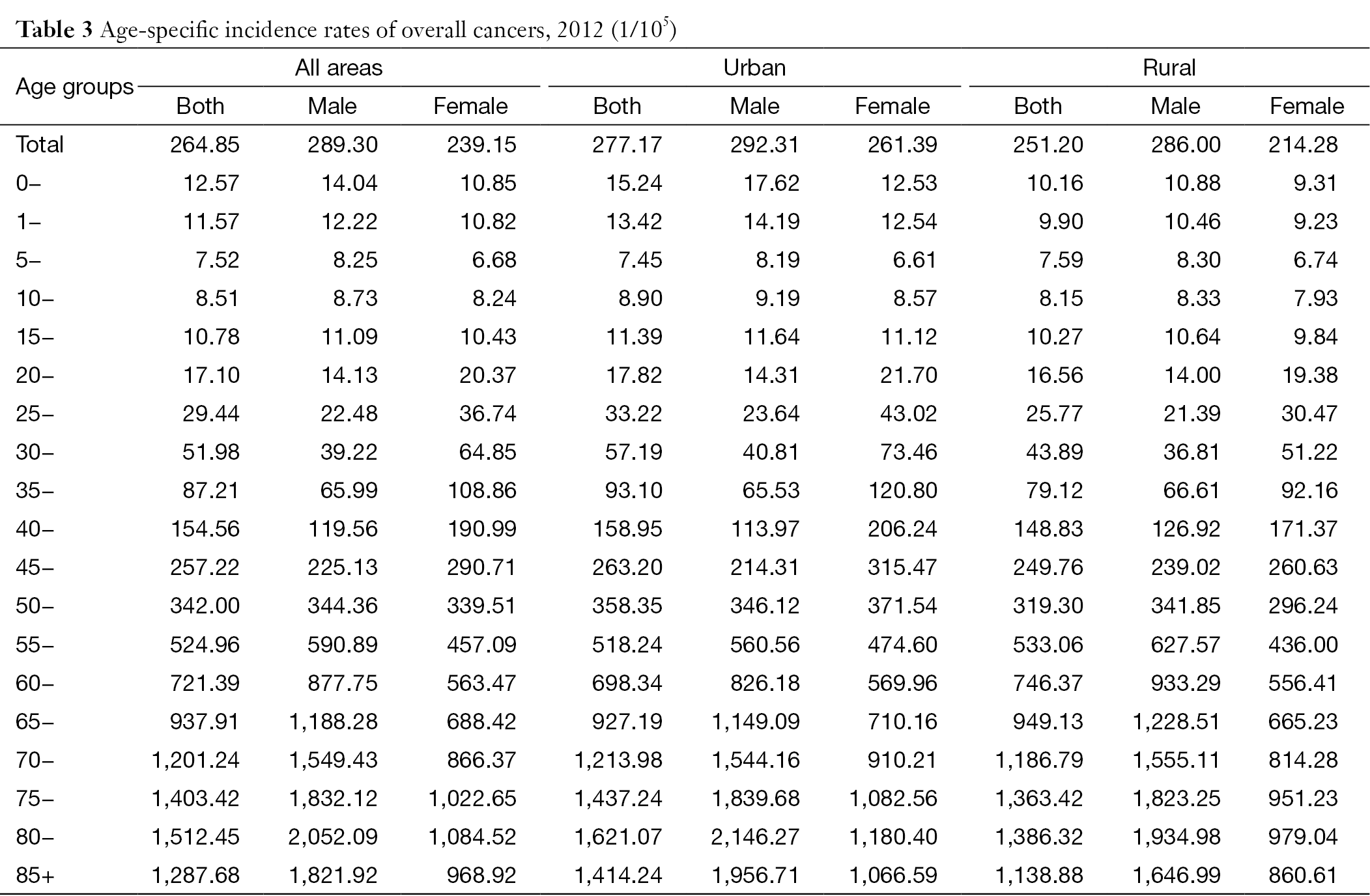
Full table
Mortality
It was estimated that there were 2,186,600 patients died from cancer in 2012. The crude mortality of all cancers in China was 161.49/100,000 (198.99/100,000 in males and 122.06/100,000 in females). The age-standardized mortality rates by Chinese standard population (ASMRC) and by world standard population (ASMRW) were 112.34/100,000 and 111.25/100,000, respectively. Among the patients aged 0–74 years, the cumulative mortality rate was 12.61%. The crude cancer mortality rate and age-standardized rate in rural areas were higher than that in urban areas. The crude cancer mortalities and age-standardized rate were higher in rural than in urban areas for males (Table 4).
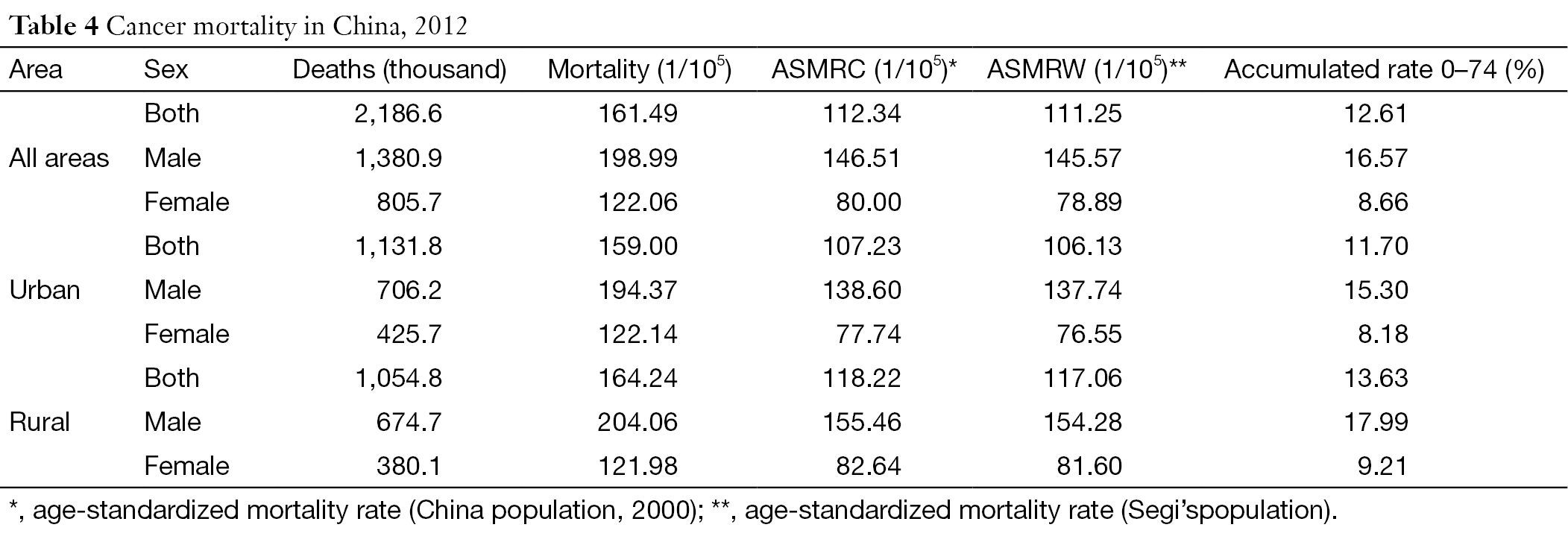
Full table
Age-specific mortality
The age-specific mortality rate was relatively lower before 45 years and then dramatically increased, reaching peak after 85 years (Table 5, Figure 2). The mortality in rural areas was higher at age group of 10–74 years, and urban areas had higher mortalities after 75 years. The mortality in rural areas was highest in the age group of 80–84 years. The age-specific mortality in urban males was lower than that in rural in most of age groups before 80 years old. In females, the mortality in urban was higher than that in rural only for age group over 75 years.
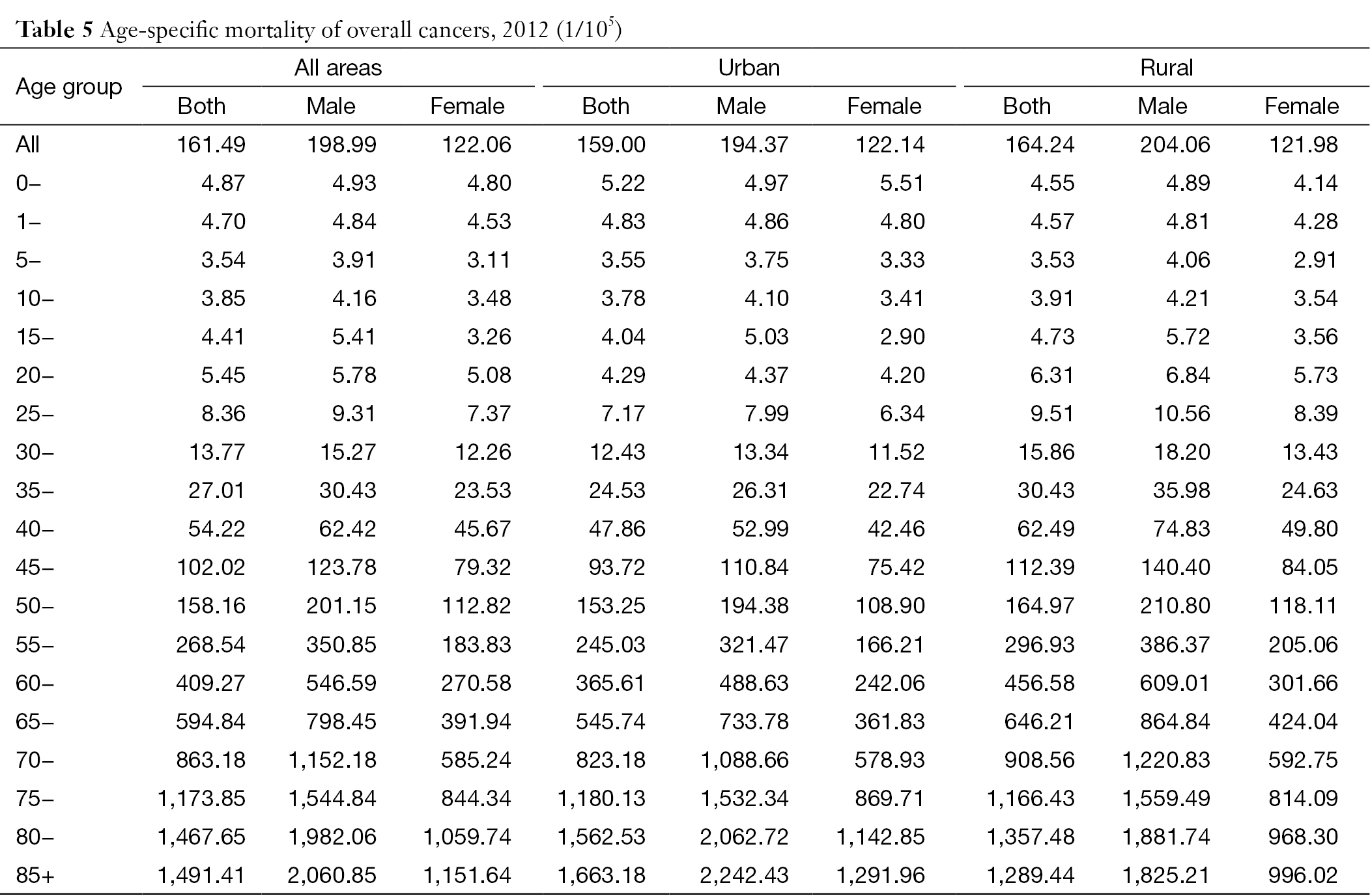
Full table
Incidence and mortality for major cancers
Cancer incidence for the 10 most common cancers
Lung cancer was the most common cancer in all areas, followed by stomach cancer, liver cancer, colorectal cancer and esophagus cancer with estimated new cases of 704,800, 423,500, 366,100, 331,300 and 286,700 respectively. Lung cancer was the most frequently diagnosed cancers in males followed by stomach cancer, liver cancer, esophageal cancer and colorectal cancer. Breast cancer was the most common cancer in females followed by lung cancer, colorectal cancer, stomach cancer and cervical cancer (Table 6).
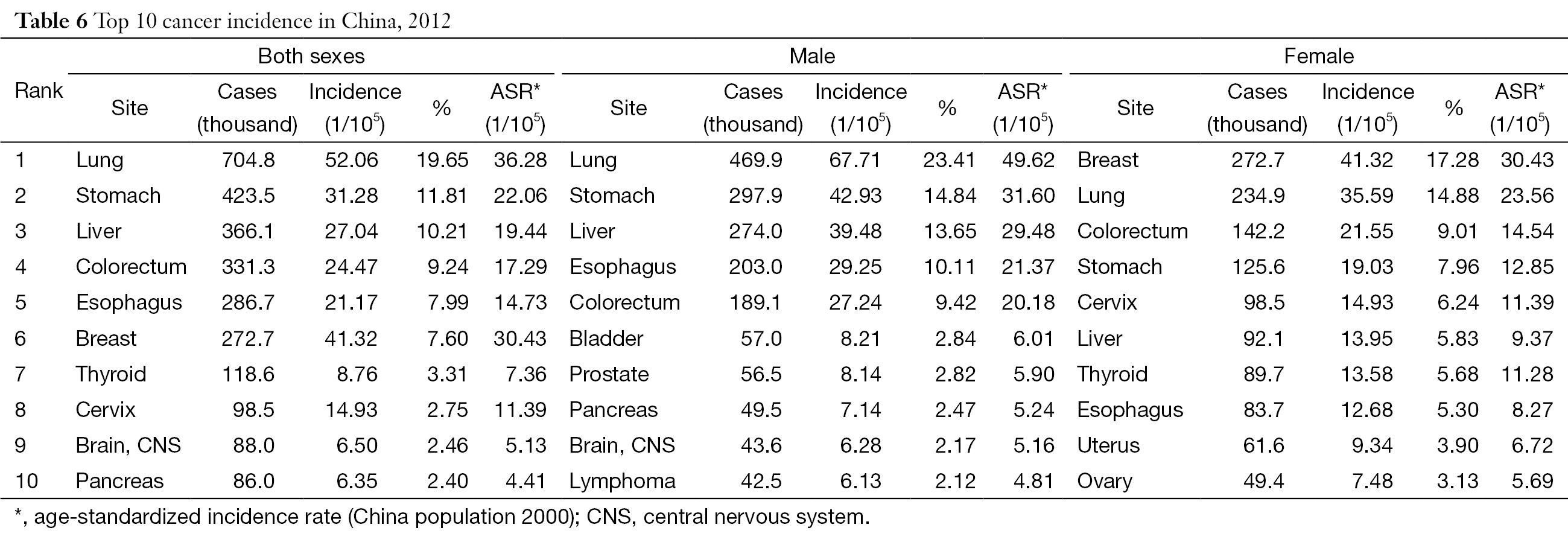
Full table
Cancer death of the top 10 cancers
Lung cancer was the leading cause of death in China followed by liver cancer, stomach cancer, esophageal cancer and colorectal cancer with estimated deaths of 569,400, 321,200, 298,500, 210,900 and 159,300, respectively. In males, lung cancer was the leading cause followed by liver cancer, stomach cancer, esophageal cancer and colorectal cancer; while in females, lung cancer was still the leading cause followed by stomach cancer, liver cancer, colorectal cancer and esophageal cancer (Table 7).

Full table
Cancer incidence of the 10 most common cancers in urban areas
In urban areas, lung cancer was the most frequently diagnosed cancers, followed by colorectal cancer, stomach cancer, female breast cancer and liver cancer with the estimated new cases of 378,200, 210,800, 197,700, 180,600 and 171,900, respectively. The most common sites of cancer were lung, stomach, liver, colon-rectum and esophagus in males, while in females, cancers of breast, lung, colon-rectum, thyroid and stomach were the most common cancers (Table 8).

Full table
Cancer death of the top 10 cancers in urban areas
Lung cancer was the leading cause of cancer death in urban areas for both males and females with estimated number of deaths of 208,500 and 100,900, respectively. Other cancer types with high mortality in males were liver cancer, stomach cancer, colorectal cancer and esophageal cancer. In females, stomach cancer was the second cause of cancer death, followed by colorectal cancer, liver cancer and breast cancer (Table 9).
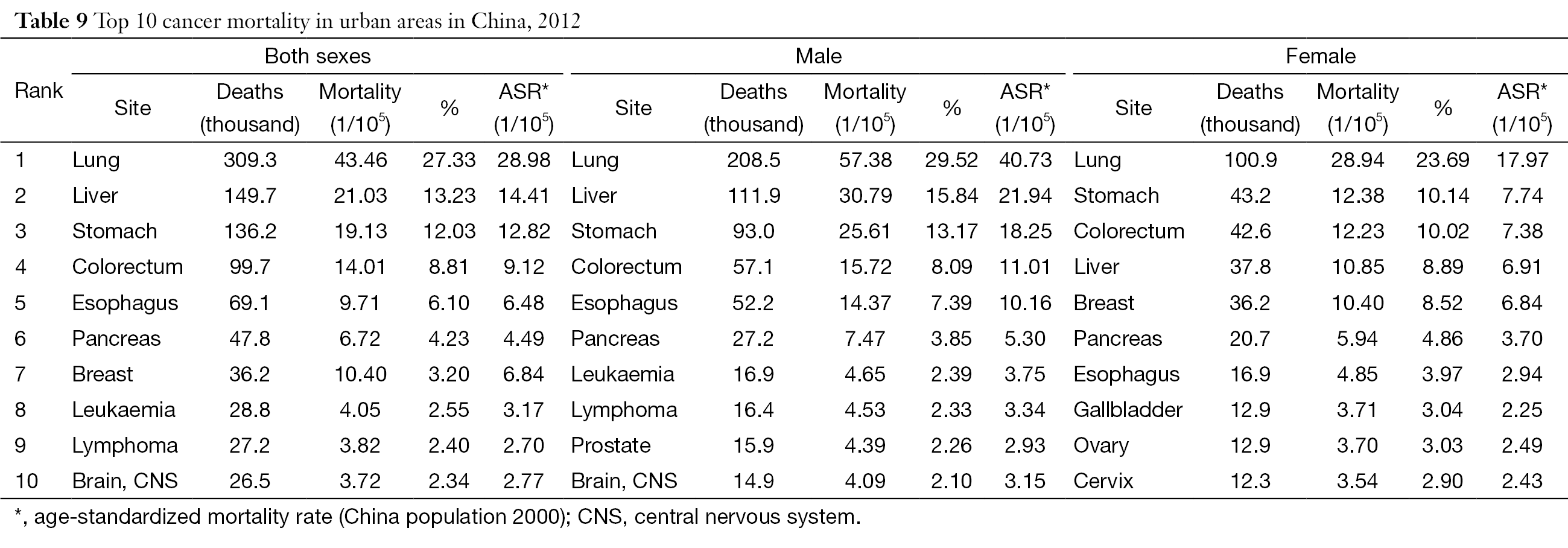
Full table
Cancer incidence of the 10 most common cancers in rural areas
Table 10 shows the 10 most common cancer incidence rate in rural areas. Lung cancer was the most frequently diagnosed cancers with estimated new cases of 326,600 and incidence rate of 50.86/100,000, followed by stomach cancer, esophageal cancer, liver cancer, and colorectal cancer. The most common sites of cancer in males were lung, stomach, liver, esophagus and colon-rectum, while in females, they were lung cancer, breast cancer, stomach cancer, esophageal cancer and colorectal cancer (Table 10).
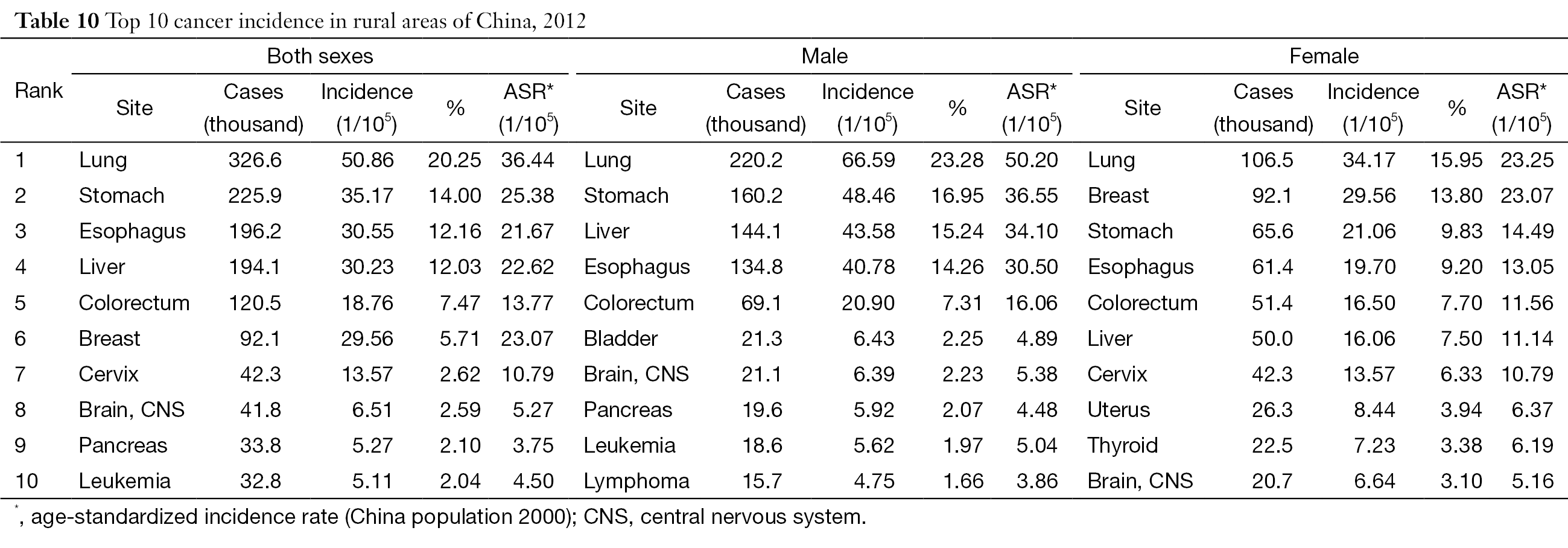
Full table
Cancer death of the top 10 cancers in rural areas
Lung cancer was the leading cause of cancer death in rural areas for both males and females. The number of deaths on lung cancer in rural was 260,100 with mortality of 40.50/100,000. The other cancer types with high mortality were liver cancer, stomach cancer, esophageal cancer and colorectal cancer in males; stomach cancer, liver cancer, esophageal cancer and colorectal cancer in females (Table 11).
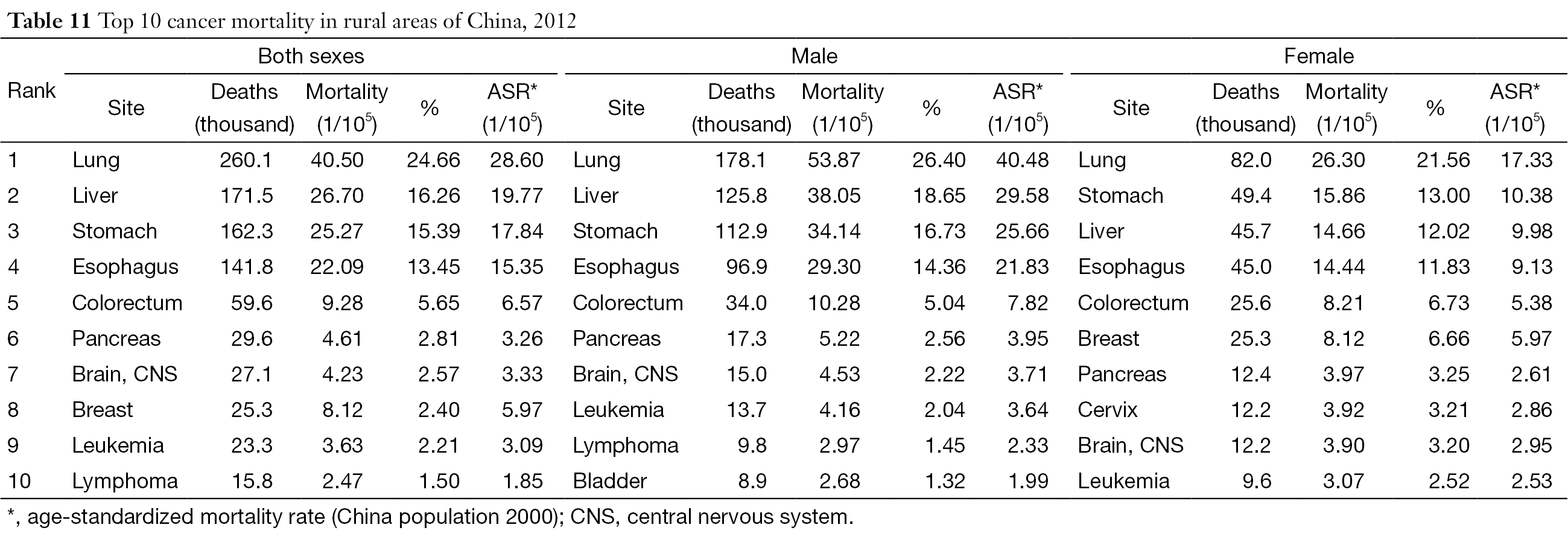
Full table
Discussion
Since 2006, NCCR of China has been publishing cancer statistics annually based on registries’ data. The updated cancer statistics published every year are important for observing the changes of cancer rates and useful to make instructions on cancer prevention and control.
In 2015, 261 cancer registries submitted registration data to the NCCR as usual, which were 27 more compared to that in 2011 (5). The population coverage of all registries was about 239 million, accounting for 17.6% of national populations. In order to ensure the reliability of cancer registration data, stringent quality control process is used based on the national criteria issued in program protocol. The incidence, mortality and population from a same registry have to keep reasonable levels compared to past data. If the data are uncompleted, inexplicable or illogical, they would be sent back to the registries for check and modification. The indicators of completeness, comparability and invalidity, such as, MV%, DCO%, MI ratio, UB% and percentage of cancer with undefined or unknown primary site (secondary) (O&U%) were evaluated for each registry’s data to judge if submitted data are valid or not. There were 193 registries’ data qualified for the update cancer incidence and mortality in 2012. They distributed in 29 provinces, autonomous regions and municipalities, and covered 14.63% of the national population at the end of 2012.
The estimated new cancer cases and deaths were 3.59 million and 2.19 million in 2012, respectively. Compared to the data in 2011, crude incidence and mortality rates were higher in 2012, after adjusted by age, incidence rate was still higher, however, mortality rate was slightly lower than that in 2011 (5). As a basic measure to monitor cancer information, cancer registration in China has been making a great progress in recent years (6). There were 27 more registries submitted cancer data to NCCR and 16 more qualified registries accepted for final analysis compared to 2011.
China had higher incidence rate and lower mortality rate in urban areas than that in rural areas and cancer patterns are quite different. Lung cancer was the most common cancer and the leading cause of cancer death both in urban and rural areas. Cigarette smoking, radon, secondhand smoke exposure would be major factors associated with lung cancer (7). Indoor smoking may be the main reason for lung cancer in rural areas (8). Breast cancer and colorectal cancer are more common in urban, mainly because more urban people lived a western and physical inactively lifestyle. In urban females, cervical cancer and thyroid cancer had ranked fifth and seventh, respectively, which needs to be paid more attention. Cancers from upper digestive system are still the frequent cancers in rural areas, health education and promotion and early detection should be placed priority in cancer strategies. Based on the current situation, different strategies should be implemented in different regions. Attention should not only be paid to the cancer with high incidence and mortality rates, but also to the cancer with rapid increasing trend. According to the population-based survival study in China, survival in rural areas was only half of that in urban areas (9). The main reason may be poor quality of cancer care and limited medical treatment for patients living in rural China. The government should balance the medical resources and take effective measures to bridge the gap.
With the economic development and changes associated with urbanization, as well as the growth and aging population, the incidence and mortality keep increasing in China (10,11). Targeted prevention, early detection, and treatment programs should be carried out by health department to control the increasing cancer burden.
Acknowledgements
We gratefully acknowledged the cooperation of all the population-based cancer registries in providing cancer statistics, data collection, sorting, verification and database creation. The authors assume full responsibility for analyses and interpretation of these data.
Footnote
Conflicts of Interest: The authors have no conflicts of interest to declare.
References
- China Statistical Yearbook, 2010. Beijing: China Statistics Press, 2010.
- Parkin DM. The evolution of the population-based cancer registry. Nat Rev Cancer 2006;6:603-12. [PubMed]
- Cancer incidence in five continents. Volume IX. IARC Sci Publ 2008.1-837. [PubMed]
- Ferlay J. The IARC crgTools Programs. Lyon: IARC, 2006. Available online: http://www.ljemail.org/reference/ReferencesPapers.aspx?ReferenceID=1210715
- Chen W, Zheng R, Zeng H, et al. Annual report on status of cancer in China, 2011. Chin J Cancer Res 2015;27:2-12. [PubMed]
- Wei KR, Chen WQ, Zhang SW, et al. Cancer registration in the Peoples Republic of China. Asian Pac J Cancer Prev 2012;13:4209-14. [PubMed]
- Ridge CA, McErlean AM, Ginsberg MS. Epidemiology of lung cancer. Semin Intervent Radiol 2013;30:93-8. [PubMed]
- Seow WJ, Hu W, Vermeulen R, et al. Household air pollution and lung cancer in China: a review of studies in Xuanwei. Chin J Cancer 2014;33:471-5. [PubMed]
- Zeng H, Zheng R, Guo Y, et al. Cancer survival in China, 2003-2005: a population-based study. Int J Cancer 2015;136:1921-30. [PubMed]
- Chen WQ, Zheng RS, Zeng HM, et al. Trend analysis and projection of cancer incidence in China between 1989 and 2008. Zhonghua Zhong Liu Za Zhi 2012;34:517-24. [PubMed]
- Zeng HM, Zheng RS, Zhang SW, et al. Trend analysis of cancer mortality in China between 1989 and 2008. Zhonghua Zhong Liu Za Zhi 2012;34:525-31. [PubMed]


